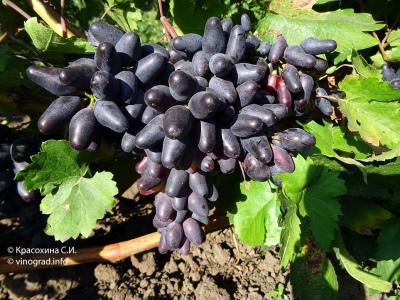
- Authors: IViV them. V.E. Tairova
- Appointment: dining room
- Berry color: black
- Taste: harmonious
- With bones: Yes
- Ripening period: mid-late
- Ripening period, days: 140-145
- Frost resistance, ° C: -17
- Name synonyms: Black souvenir, Satellite
- Bunch weight, g: 252
Odessa souvenir is a very fruitful grape variety. It is excellent for cultivation in the southern regions for sale and technical use.
Breeding history
It was first obtained by crossing two grape varieties, namely: Hamburg Muscat and Moldavian. Academician V. Ye. Tairov can be conditionally considered his "parent". The homeland of this variety is Ukraine. He was taken out in the Odessa IViV, which bears the name of V.E. Tairov. This species has other names, the most common in everyday life is Sputnik. And also because of its color it is called the Black Souvenir.
Geography of distribution
The variety grows well in Ukraine, in the southern regions of the Odessa and Kherson regions. He took root well in the Crimea and throughout the Black Sea region. It grows in areas with a warm southern climate, because it is a thermophilic variety that prefers sunlight.
Description
According to the strength of growth, it belongs to the vigorous ones. It has a rather powerful bush in terms of development. Shoots during the growing season change color from light green to dark brown. The vines are very resilient. On the shoots, medium-sized leaves grow, in which the central part is elongated. Below they have a slight pubescence. During the flowering period, the bush is covered with inflorescences.
Ripening period
From growing season to fruiting, 140-145 days pass. The variety is considered medium late. It has a significant disadvantage - a long ripening period.
Bunches
Rather loose in structure, the bunches are conical in shape and have a very low tendency to pea. Weight is up to 252 g.
Berries
The berries are black, but this is during full ripening. In the process, they change their color from dark red to dark blue and eventually acquire a completely black color. The shape of the fruit is oblong-ovoid. They are quite dense in structure. The skin is thick and firm, covering the juicy, fleshy flesh. There are usually 3-4 seeds inside the berry. In size, the fruits of this variety are quite large - up to 3.6 g.
Taste
The berries have a full-fledged harmonious taste with a light nutmeg aroma. Tasting score - 8.4 points. Not a very sweet variety, as can be seen from the amount of sugar, which is 158 g / dm3. But it is not acidic either, since it has a low acidity equal to 7.6 g / dm3.
Yield
In terms of fruiting, it belongs to high-yielding varieties. On young shoots that have already developed, 0.8 bunches are formed, and on strong fruit-bearing ones - up to 1.2. Ripens 67% of the shoots. Due to the large weight of the bunches, the yield from the bush is high. The grape has a table purpose. It is consumed both fresh and processed. For example, jams and jams are made from it.


Growing features
To get a good large yield, the plant needs proper care. It includes the right choice of soil and planting site. As well as post-plant care, timely watering and pruning. The soil needs mulching and loosening to ensure proper air exchange and maintain the required moisture level. Moisture stagnation adversely affects the grapes, especially on its root system, which, because of this, can undergo putrefactive diseases.
Landing
When planting, choose a well-lit area: this variety does not tolerate shade. Saplings are planted on a hill, for this they build small mounds. Young shoots are planted in any soil, since this variety bears fruit well with any soil composition. But land with a low moisture capacity is best suited.
Immediately before planting, 15 cm depressions are made in the ground, where the cutting of the plant is planted. Then the hole is sprinkled with soil, but loosely. To increase the chances of rooting, the neck of the roots of the grapes is placed slightly above ground level. The distance between the bushes should be at least one meter.
This variety is best planted in the spring season, since the plant is very poorly resistant to frost. If planted in autumn, young plants may not survive the winter and die.

Pollination
The variety is well pollinated alone, it has flowers of both sexes. During the flowering period, a large number of inflorescences are formed.
Pruning
To form a bush, regular pruning is carried out. Leave about 4 fruitful shoots. And also at the end of autumn, they carry out sanitary pruning to remove bad and non-viable parts of the grapes.



Frost resistance and the need for shelter
Odessa souvenir has a rather low frost resistance. It is able to withstand temperatures down to -17 degrees. It is a southern grape species. Cannot ripen in northern regions. She needs shelter for the winter.

Diseases and pests
The variety may well get sick with poor-quality care. It has an average resistance to fungal diseases, is resistant to gray mold and is very susceptible to powdery mildew. Requires regular preventive treatments.

If a grape is exposed to any disease or insect, this always affects its appearance.
Storage
Thanks to their strong skin, the berries lend themselves well to transportation over long distances and have a long shelf life, which makes this variety suitable for growing for sale.











































































